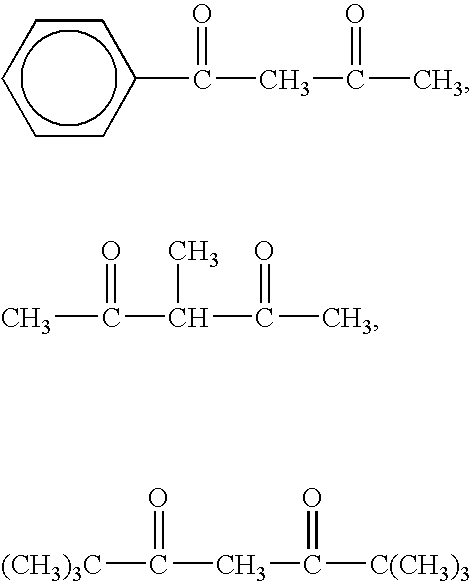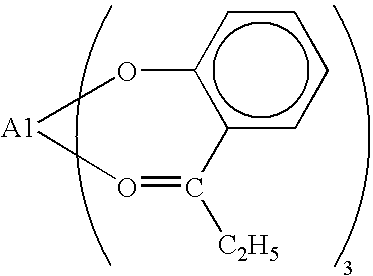Organopolysiloxane and Curable Silicone Composition that Contains Aforementioned Organopolysiloxane
a technology of organopolysiloxane and composition, applied in the field of organopolysiloxane, can solve the problems of low ultraviolet ray resistance of elements, easy browning, and optical parts that utilize the cured bodies of the aforementioned compositions cannot provide high brightness of light, and achieve high light-transmitting properties, high light-transmitting properties, and high reliability
- Summary
- Abstract
- Description
- Claims
- Application Information
AI Technical Summary
Benefits of technology
Problems solved by technology
Method used
Image
Examples
example 1
Practical Example 1
[0073]A 500 ml-flask equipped with a thermometer, a Dean-Stark tube, and a reflux cooler was loaded with 98.0 g of cyclohexyltrimethoxysilane, 10.3 g of 3-glycidoxypropylmethyl-dimethoxysilane, 10.9 g of dimethyldimethoxysilane, 80 g of toluene, and 0.13 g of potassium hydroxide. The system was combined with 30.8 g of water, and then the methanol and water were evaporated by heating the mixture. When water was completely removed, the system was cooled, and 20.0 g of water and toluene was added again. Following this, the system was heated, and the formed methanol and water were removed via evaporation. 20 g of water were added again, the formed methanol and water were removed via evaporation, and the product was subjected to 6 hour heating and refluxing. Upon cooling, 0.20 g of acetic acid was added, and the system was neutralized. Toluene was then added, and the product was washed three times with 80 ml of water. The obtained toluene solution was poured into a 500...
example 2
Practical Example 2
[0076]A 500 ml-flask equipped with a thermometer, a Dean-Stark tube, and a reflux cooler was loaded with 77.1 g of cyclohexyltrimethoxysilane, 11.2 g of octamethyltetracyclosiloxane, 6.8 g of water, and 0.06 g of trifluoromethane sulfonic acid. The formed methanol was evaporated by heating. The system was combined with 78 g of toluene, 0.17 g of potassium hydroxide, 22.2 g of 3-glycidoxypropyl methyldimethoxysilane, and 34.4 g of water. Following this, the system was heated, and the formed methanol and water were removed via evaporation. After the water was completely removed, the system was cooled and again combined with 20.0 g of water and toluene. The formed methanol and water were evaporated by heating, and the system was subjected to 6 hour heating and refluxing. Upon cooling, 0.23 g of acetic acid was added, and the system was neutralized. Toluene was then added, and the product was washed three times with 80 ml of water. The obtained toluene solution was po...
example 3
Practical Example 3
[0079]A 500 ml-flask equipped with a thermometer, a Dean-Stark tube, and a reflux cooler was loaded with 78.7 g of cyclohexyltrimethoxysilane, 22.7 g of 3-glycidoxypropylmethyl-dimethoxysilane, 18.5 g of dimethyldimethoxysilane, 79 g of toluene, and 0.16 g of potassium hydroxide. The system was combined with 30.1 g of water, and water and the formed methanol were evaporated by heating. After the water was completely removed, the system was cooled and again combined with 10.0 g of water and toluene. The formed methanol and water were evaporated by heating, and the system was subjected to 6 hour heating and refluxing. Upon cooling, 0.24 g of acetic acid was added, and the system was neutralized. Toluene was then added, and the product was washed three times with 80 ml of water. The obtained toluene solution was poured into a 500 ml flask equipped with a Dean-Stark tube, and the contents were subjected to azeotropic dehydration. Impurities were separated by filtering...
PUM
| Property | Measurement | Unit |
|---|---|---|
| refractive index | aaaaa | aaaaa |
| viscosity | aaaaa | aaaaa |
| brightness | aaaaa | aaaaa |
Abstract
Description
Claims
Application Information
 Login to View More
Login to View More - Generate Ideas
- Intellectual Property
- Life Sciences
- Materials
- Tech Scout
- Unparalleled Data Quality
- Higher Quality Content
- 60% Fewer Hallucinations
Browse by: Latest US Patents, China's latest patents, Technical Efficacy Thesaurus, Application Domain, Technology Topic, Popular Technical Reports.
© 2025 PatSnap. All rights reserved.Legal|Privacy policy|Modern Slavery Act Transparency Statement|Sitemap|About US| Contact US: help@patsnap.com



